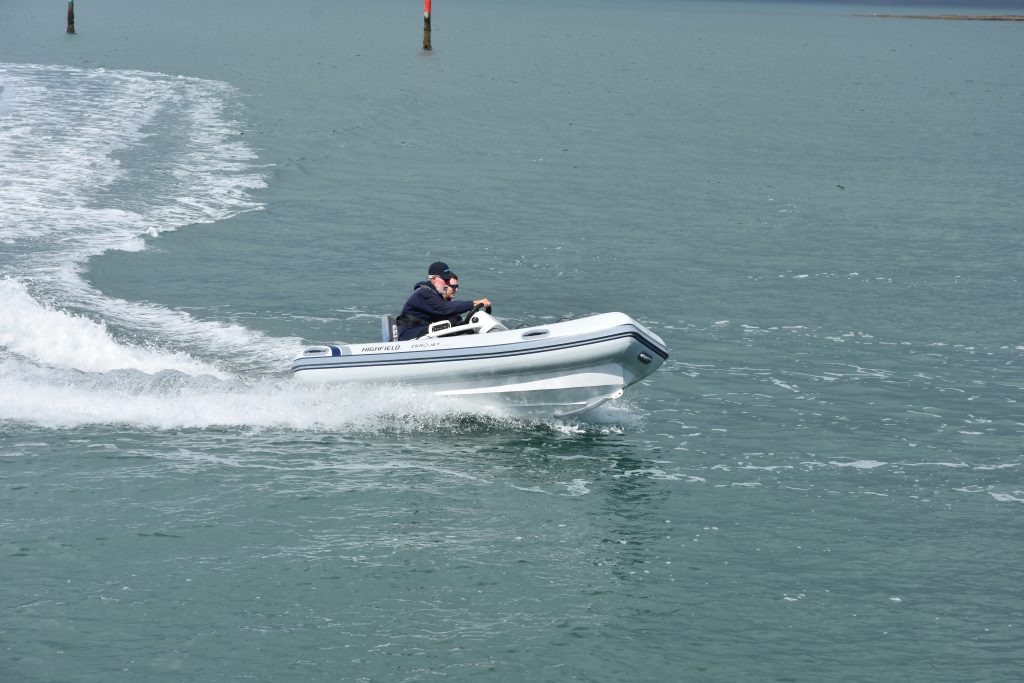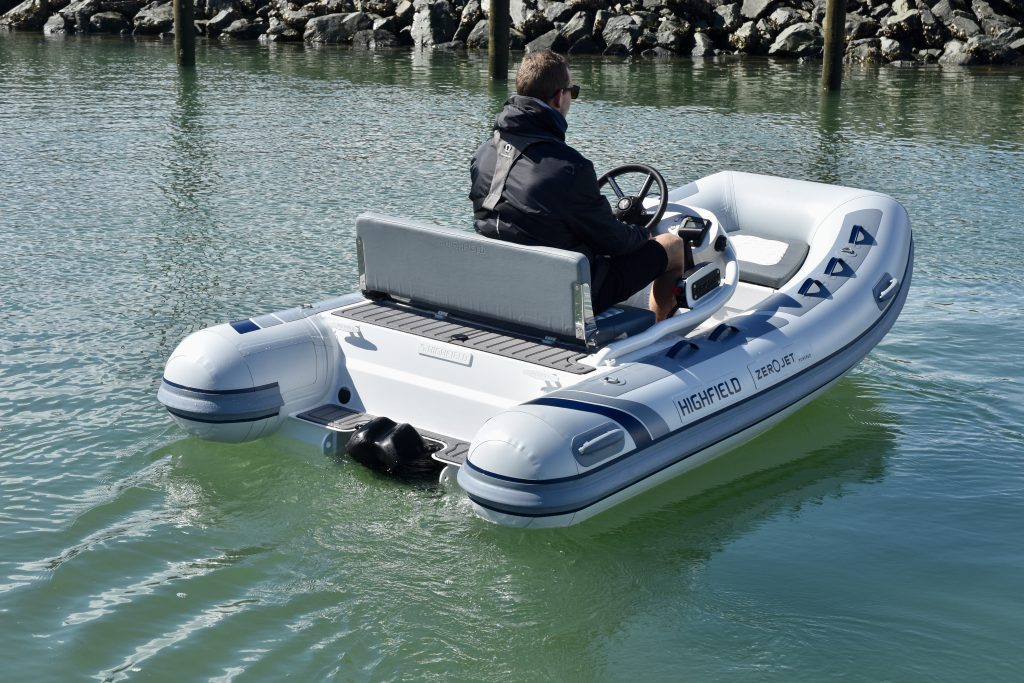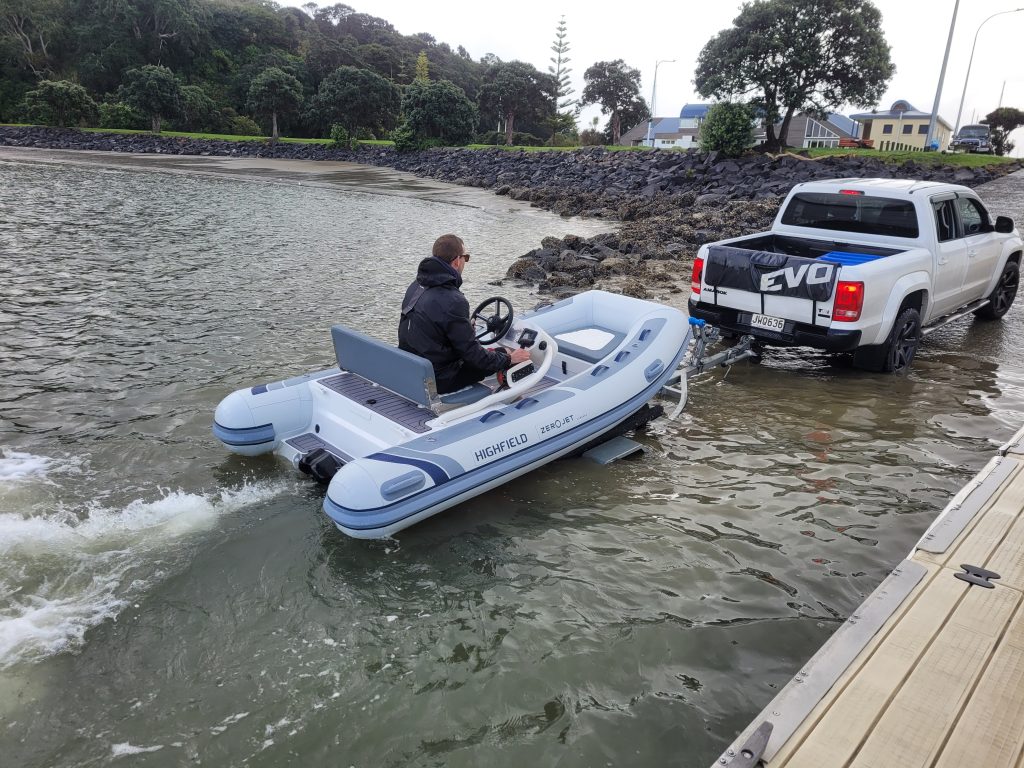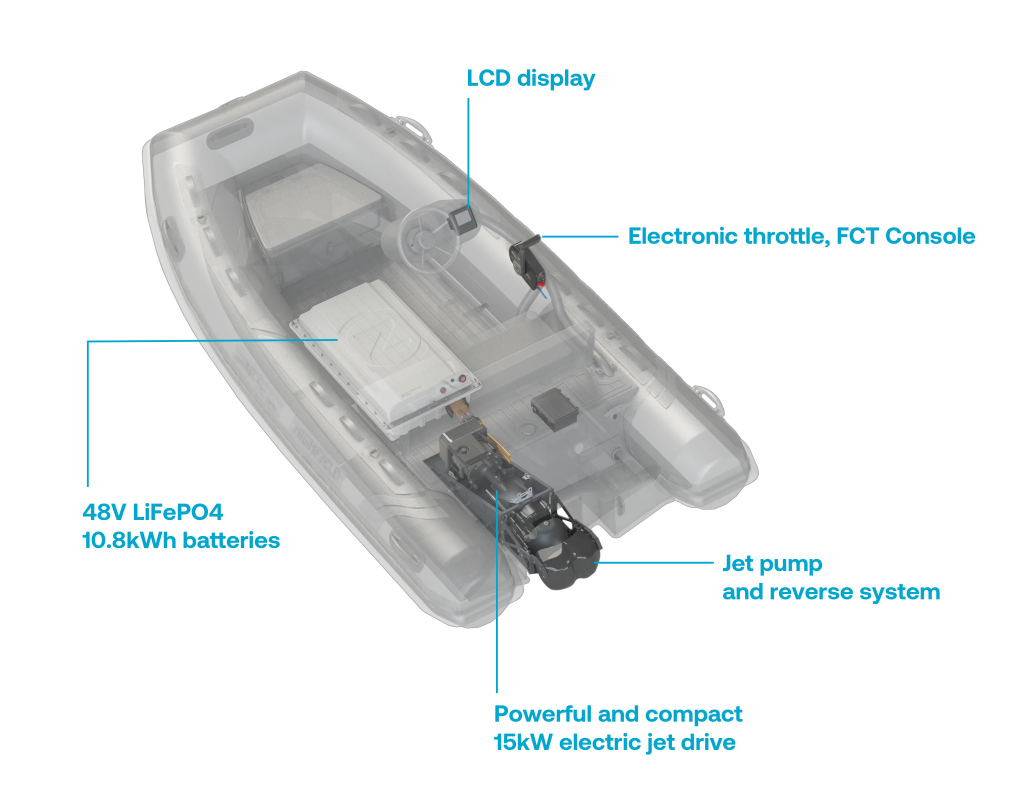Highfield Boats, arguably the world's number one in the RIB (Rigid-hull Inflatable Boat) tender sector and a global player in the 5 metre plus sector, with over 27,000 boats delivered world- wide since the brand’s inception in 2011, has recently partnered with New Zealand company ZeroJet to create the Highfield E Jet 330 powered by ZeroJet.
Sustainability is a huge part of Highfield’s DNA. All hulls and structures are built in aluminium, which is infinitely recyclable. In addition, Highfield powder coat their hulls in an enclosed area to ensure that their environmental footprint remains low from the beginning of the manufacturing process through to the end of each product’s life. Therefore, a conscious decision to manufacture and distribute electrically powered RIB tenders made perfect sense to Highfield, and thus Julien Carussi, the CEO of Highfield since 2010, started a global search for suitable electric outboard and inboard propulsion units for Highfield’s brand. Having partnered with the Chinese company, ePropulsion for their outboard electric motors, Julien’s ongoing research led him to the New Zealand company ZeroJet, for their inboard electric propulsion units. He liked what he saw during his internet research and contacted Bex Rempel and Neil Mans, the co-founders of ZeroJet and the rest, as they say, is fast becoming history. Both companies recognised the obvious synergy, not only with their products, but in their philosophy of going greener with something which would counter the carbon footprint of fossil fuel powered watercraft. In rapid time, after a few initial meetings, Highfield shipped a 330 model RIB to New Zealand to be fitted with a ZeroJet propulsion system and batteries. After a bit of experimentation by both parties, and a few prototypes later, the current E Jet 330 was ready for market. Introduced earlier this year at the prestigious Dusseldorf Boat Show, and recently exhibited at the Auckland On-Water Show, Pacific Powerboat (PPB) magazine was subsequently invited to sea trial the boat and propulsion package. About eighteen months ago, on behalf of PPB, I sea trialled the ZeroJet System fitted to an OCT 3.5 metre tender (ref March/April 2022 issue). At the time, I was mightily impressed, and my article concluded with the following statement: “There is little doubt in my mind that ZeroJet will soon see a massive international interest in their innovative Kiwi product. Watch this space”. Well, on a cold, wet, blustery spring day in Auckland during the last week of September, I was able to ‘watch this space’ when time and conditions allowed me to conduct a sea trial of the new Highfield E Jet 330 RIB. My words from a year and a half ago turned out to be quite prophetic. The collaboration with Highfield proving that indeed there is massive international interest in ZeroJet. When last I wrote about ZeroJet, I had zero expectations. This time I had quite high expectations and I was determined to push both the boat and propulsion unit to the max to see if my higher expectations were going to be met. From the onset the folks at ZeroJet had focused their sights on smaller boats in the 3m to 4m range. Thus, collaborating with Highfield to power their 3.3m RIB made perfect sense. An added bonus for ZeroJet is the fact that they indirectly become part of Highfield’s extensive global distribution network, assuring customers of ongoing back up and service no matter where in the world they are located.

Highfield recognised and acknowledged the general benefits of electric over ICE (Internal Combustion Engine) propulsion. In addition to the obvious advantages – no petrol or diesel emissions, less noise, fewer moving parts, less maintenance, and a faster start – there are several additional rewards for inboard electric jet units when compared to electric outboards:
- No exposed propeller means safer use in the water and safer swimming.
- Without an outboard shaft, the low-profile RIB hull makes beaching easy and allows the boat to skim over shallow ecosystems.
- The more compact profile makes it easier to stow and store in smaller spaces.
- The ZeroJet 15 kW electric motor and jet pump unit is compact and inboard, meaning more space on the boat compared to an equivalent outboard engine.

Having used, tested, and enjoyed small RIBs over many years of boating and diving, I fully expected the Highfield 330 to embody all the best that a RIB has to offer with minimal, if any, negatives. After all, a company only manages to sell tens of thousands of inflatables, by getting things right. Yes? But lots of boat builders get many things right, so what sets this Highfield E Jet 330 apart? That was why we were braving the early spring frequent squalls and cold temperatures off Whangaparaoa Peninsula to find out. It was vitally important that the sea trials be conducted on this particular day as the boat was being crated up and sent to Florida later the same day for the Fort Lauderdale Boat Show at the end of October.
No pressure!
Launching the E Jet 330 at the Gulf Harbour boat ramp was quick and easy. Simply back the trailer down the ramp, immerse hull and slide boat off the custom trailer once wheels are fender deep. Although the Highfield NZ Distributor (Aakron Xpress) provide a trailer if required, this is offered as an option, as most of these boats will likely end up being used as tenders for large, luxury pleasure craft. After launching and tying up alongside the boat ramp dock, Zane and I hopped aboard and headed out to sea. Zane briefed me on the controls, instruments and general features of the boat and jet drive as we silently navigated the channel out to open water. When it comes to actual operation, what’s different between this 3.3m RIB equipped with an outboard versus a ZeroJet inboard unit? Not much as it turned out. In other words, if you are used to driving a small helm-station RIB with a conventional outboard, it doesn’t take much to learn how to operate a similar ZeroJet equipped craft. Idling out to open water, one is amazed at the quietness of this vessel and, with time to look around the boat before opening her up once past the breakwater, several features impressed. Perhaps the most immediate is the FCT Console (a one-piece combination seating/steering console that secures to the aluminium deck), a Highfield concept with only a few changes made to suit the ZeroJet propulsion unit. This uniquely designed console allows for all controls and instrumentation to be housed in a module that seems to float independentlyfrom the rest of theboat. It is futuristic, unintrusive and ergonomically situated for intuitive use of the throttle and steering wheel, while also housing the simple to reach and use instrumentation, consisting of only two panels. One being the variable mode LCD electronic display. The Drive Mode shows the motor power in use, speed in knots (from a GPS) and the percentage charge of the battery. When the charger is plugged in, the Charging Mode is displayed, showing the estimated charging time. The other panel consisting of four simple buttons to control the bilge pump, navigation lights, deck lights and courtesy/mooring light. Seemingly Spartan but offering everything that is required. However, if you wanted to retrofit a GPS/Fishfinder unit for example, this could easily be integrated into the FCT unit, as there is ample space on the top of the console and volume aplenty inside the rounded oblong ‘box’. The ZeroJet propulsion system is housed beneath the two-person, aft orientated seat, which has a back rest that can lay flat for ease of movement around the boat, and which also allows unrestricted access to the stern, which is fitted with a small but useable swim platform extending the full width of the stern between the Hypalon tubes. This feature is not available with an electric outboard set up, as the outboard takes up too much space. Another plus for the ZeroJet system. The 48V LiFePO4 batteries (10.8kWh) are housed in a bespoke, watertight battery box under the brushed foam teak finish deck, which can be accessed by simply unbolting the deck floorboards. Up forward is a waterproof bow locker with more than ample space for spare clothing, etc. and when shut, it serves as a padded seat. In my opinion, this vessel is ideally suited for two to four people, even though it is rated for five, maximum. With only two people, it is perfect. The helm station is well designed for the driver and companion to sit comfortably beside each other while allowing the helmsperson ample room to steer the boat and operate the forward/aft throttle unit attached to the arm of the FCT console. As mentioned above, the throttle works pretty much the same as an outboard unit, the only key difference I noted is that it takes a bit more of a definitive downward thrust when engaging reverse and it is important to remember that one needs to progress in stages from forward throttle to neutral to reverse. The reason for this is simple to understand, when you appreciate that what you are doing is mechanically altering the position of the stern jet pod which, as you would suspect, is heavier and bulkier than a propeller. Enough said, time to rock and roll!

Despite the blustery weather, we were able find relatively calm waters outside the breakwater to put the E Jet 330 through its paces. Zane piloted the boat initially so I could learn how she handled at several throttle speeds and through various low and high-speed manoeuvres before I took over the helm, so as not to make a complete fool of myself. While watching Zane, it soon became apparent that there were a few key differences with this propulsion system versus an outboard motor set-up and when it was my turn to drive, these differences became abundantly clear.
First off; Acceleration. Over the past decade there has been a lot of hoopla around the insane acceleration that electric vehicles are able to achieve compared to their fossil fuel brethren. So too is it true when it comes to marine electric jet propulsion. You hit that throttle full forward and the boat jumps instantly up on the plane and, in super quick time, we hit our maximum recorded speed for the day, of 19 knots. Exhilarating to say the least!
Second; Sound. There is a lot of hype over how quiet electric boats are, and for the most part, this is true. However, with the E Jet 330, there is some noise. Not from the electric motor, but from the volume of water being thrust through the jet propulsion unit. Basic physics. But is this noise annoying? Not in the least. And compared to the noise an outboard generates, even though modern four stroke units are a way down on the decibel level, compared to good old two stroke units, the ZeroJet unit is noticeably quieter.
Third; Handling. Here is where you experience a difference between a RIB of this size fitted with a conventional 20 hp equivalent outboard and the ZeroJet drive. The helm is somewhat ‘heavier’ when you push the boat at speed through tight turns. Not surprisingly, when you think about it, as there is a lot of hefty ‘jet-pod ’ at the stern to move around. In discussion with Jonathan Tuboeuf, the director of Highfield operations in New Zealand, when I mentioned this to him, he advised that the steering is conventional mechanical cable. I suggested that perhaps hydraulic steering may alleviate some of this ‘heaviness’ when careening the craft around at high speeds? As the E Jet 330 package is still evolving, this may be something for consideration? That tiny niggle aside, once you start putting this RIB through tight turns at high speeds, the exhilaration of the ride soon puts all other thoughts from your mind! When Zane jumped ashore and handed the helm over to me before I headed back out on my own, my immediate question was; “How hard can I push this craft”? Receiving his “Go for it” response, I went for it! With increasing confidence, I pushed harder and harder, bouncing the 330 through a short chop and executing alarmingly tight turns, thinking to myself that if this all turns to custard, at least I’ve got my inflatable life jacket on, and the kill switch cord is securely looped around my leg! As it turned out, my concerns were ill-founded. No matter how hard I tried to ‘unhinge’ the E Jet from the ocean surface, it just dug its ass in and kept going. Although I haven’t had the opportunity to test a 330 with a conventional outboard, I suspect that if I were to do the same manoeuvres the stern would have let loose. Although this craft is tremendously pragmatic in this age of alternative fuel consideration and, for much of its use will be simply ferrying people and supplies from shore to boat and vice versa, this is also a safe, fun boat. With no exposed propeller and abundant power, this little craft is ideal for water skiing or towing the kids around on a sea biscuit, not to mention that its low profile (draft) allows it to be beached easily and to skim over shallow reef ecosystems. Sea trials completed, we returned to the boat ramp to wrap up the day. I mentioned launching was easy, well retrieving the boat is equally easy. Once the trailer is backed down into the water and submerged to its wheel arches, simply power the boat onto the trailer and secure it. Job done! After that, it’s just a matter of plugging the boat into your home charger or (if stowed in a large vessel ‘parking garage’) onboard power source.
Conclusion: This is the complete package, but it does, as one would expect with a top quality, state of the art product, not come cheap (starting at NZD $55,000.00 without trailer). Cost aside, there is little to find fault with the E Jet 330 powered by ZeroJet. As I said in the conclusion of my previous ZeroJet article. No pollution, minimal noise. Just you, the ocean, and a rechargeable battery. I like that!

FEATURES
Hypalon tubes, High tensile chromated & powder coated Aluminium, Deep V Hull, 15 kW/ 20 hp ZeroJet drive, 48 V system, 40A charger (requires a 16A socket & AC 90 – 264V power source), 10.8 kWh battery packs (underfloor-mounted), Eliminates the necessity of having dangerous petrol on board the mother ship, LCD display, Electronic, with a mechanical reverse throttle, Wheel and steering system. FCT console, 20-degree hull deadrise angle gives handling assurance in the toughest conditions, Flush Mount non-return valves, Bow Locker, Integrated Transom Supports, Removable Set Lifting points and Towing Eyes, Tow bridle points, Brushed Foam Teak Finish deck, Heavy duty rubbing strake, Full length keel guard, Tank strap kit, Highfield dry bag, Foot pump, Oars.
SPECIFICATIONS
- Boat Design Name Highfield E Jet 330
- Overall length 336cm
- Overall width 182cm
- Tube diameter 43cm
- Number of air chambers 3
- Maximum load 425kg
- Boat weight from 225kg
- Price (without trailer) from NZD $55,000
ZEROJET SYSTEM SPECIFICATIONS
Includes batteries, throttle, and LCD display
- Battery (kWh) 10.8
- Nominal voltage (V) 48
- Power (kW) (20 hp equivalent) 15
- Maximum speed (knots)* 20
- Range @ 3 knots speed (nautical miles) * 23
- Range @ 14 knots speed (nautical miles) * 12
- Runtime @ 3 knots speed (hours) 7.5
- Runtime @ 14 knots speed (hours) 1
- Charge time 40A charger at 220V (hours) 4
*Based on a standard 1-person load




